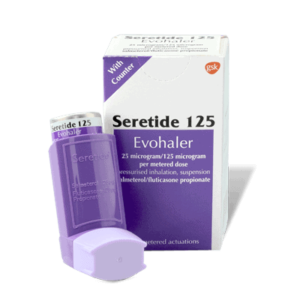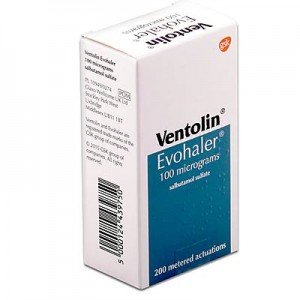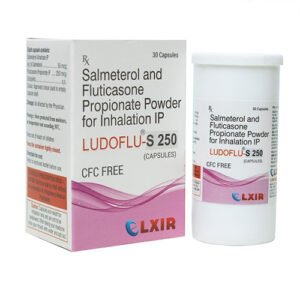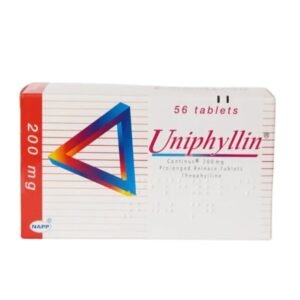What is Trelegy Ellipta?
Trelegy Ellipta BNF contains three active ingredients called fluticasone furoate, umeclidinium bromide, and vilanterol. Fluticasone furoate belongs to a group of medicines called corticosteroids, often simply called steroids. Umeclidinium bromide and vilanterol belong to a group of medications called bronchodilators.
How does Trelegy Ellipta work?
Fluticasone furoate/umeclidinium/vilanterol is a combination of a synthetic inhaled corticosteroid, a long-acting muscarinic receptor antagonist, and a long-acting beta2-adrenergic agonist (ICS / LAMA / LABA). Following oral inhalation, umeclidinium and vilanterol act locally in the airways to produce bronchodilation by different mechanisms of action, and fluticasone furoate reduces inflammation.
Fluticasone furoate
Fluticasone furoate is a corticosteroid with potent anti-inflammatory activity. The exact mechanism by which fluticasone furoate acts on COPD symptoms is unknown. Corticosteroids have been shown to have a wide variety of action on multiple cell types (eg, eosinophils, macrophages, lymphocytes) and on mediators involved in inflammation (eg, cytokines and chemokines).
Umeclidinium
Umeclidinium is a long-acting muscarinic receptor antagonist (also known as an anticholinergic). Umeclidinium exerts its bronchodilator activity by competitively inhibiting the binding of acetylcholine to the muscarinic receptors of the bronchial smooth muscle. In pre-clinical studies, it is shown to have slow reversibility in vitro in human M3 muscarinic receptor subtypes and a long duration of action in vivo when administered directly to the lungs.
Vilanterol
Vilanterol is a selective long-acting beta2-adrenergic agonist (LABA). The pharmacological effect of beta2-adrenergic agonist drugs, including vilanterol, are at least in part attributable to stimulation of intracellular adenylate cyclase, the enzyme that catalyzes the transformation of adenosine triphosphate (ATP) to adenosine monophosphate – 3 ‘, 5 ‘cyclical (cyclic AMP). The increase in cyclic AMP levels causes relaxation of the bronchial smooth muscle and inhibition of the release of mediators of immediate hypersensitivity of cells, especially mast cells.
What are the benefits of using Trelegy Ellipta?
How to use Tregely Ellipta and its dosage?
Always use this medicine exactly as your doctor has told you. If in doubt, consult your doctor or pharmacist again.
The recommended dose is one inhalation every day, at the same time each day. You only need one inhalation a day, as the effect of this medicine lasts for 24 hours.
Do not use more doses than your doctor has told you.
Use Trelegy Ellipta regularly
It is very important that you use Trelegy Ellipta every day, as your doctor has told you. This will help you to have no symptoms throughout the day and night.
Trelegy Ellipta should not be used to relieve a sudden attack of choking or wheezing. If you have this type of attack, you should use a quick-acting “rescue” inhaler (such as salbutamol).
How to use the trelegy ellipta inhaler
Trelegy Ellipta is ready for use once the tray is opened.
What are the Side effects & precautions of Trelegy Ellipta?
Like all medicines, this medicine can cause side effects, although not everybody gets them.
Urgent breathing difficulties
If your breathing or wheezing worsens immediately after using this medicine, stop using it and seek medical help immediately.
Pneumonia (infection of the lungs) in patients with COPD (frequent side effect)
If you experience any of the symptoms listed below while using Trelegy Ellipta, consult your doctor. They could be symptoms of a lung infection:
- fever or chills
- increased production of mucus, change in mucus color
- increased cough or increased difficulty breathing
Frequent side effects, they can affect up to 1 in 10 people:
- canker sores, bumps (bumps) in the mouth or throat caused by a fungal infection (yeast infection). Rinse your mouth with water immediately after using Trelegy Ellipta can help prevent this side effect.
- infection of the nose, sinuses or throat
- upper respiratory infection
- itchy, runny or stuffy nose
- pain in the back of the mouth and throat
- inflammation of the sinuses
- inflammation of the lungs (bronchitis)
- flu
- common cold
- headache
- cough
- frequent and painful urination (may be signs of urinary tract infection)
- joint pain
- Back pain
- constipation
Uncommon side effects, they can affect up to 1 in 100 people:
- irregular heartbeat
- faster heartbeat
- hoarseness
- A weakening of the bones that can cause fractures.
Interaction with beta-blockers
Beta2-adrenergic blockers can decrease or antagonize the effect of beta2-adrenergic agonists such as vilanterol. If the administration of beta-blockers is required, cardioselective beta-blockers should be considered, although caution should be exercised during concomitant use of both non-selective and selective beta-blockers.
Interaction with CYP3A4 inhibitors
Fluticasone furoate and vilanterol both undergo rapid clearance due to intense first-pass metabolism mediated by the liver enzyme CYP3A4.
Caution is advised when administering this medicinal product together with potent CYP3A4 inhibitors (eg ketoconazole, ritonavir, cobicistat-containing medicinal products), as increased systemic exposure of both fluticasone furoate and vilanterol is possible, resulting in May cause a potential increase in adverse reactions.







